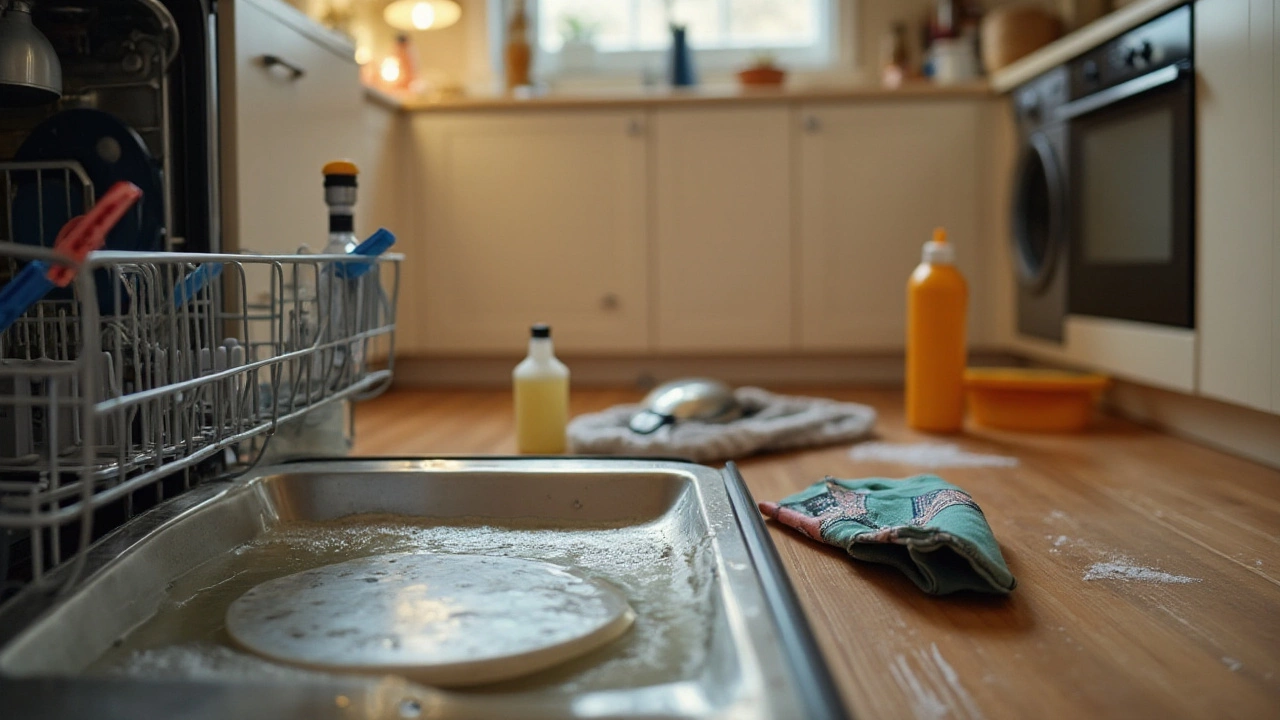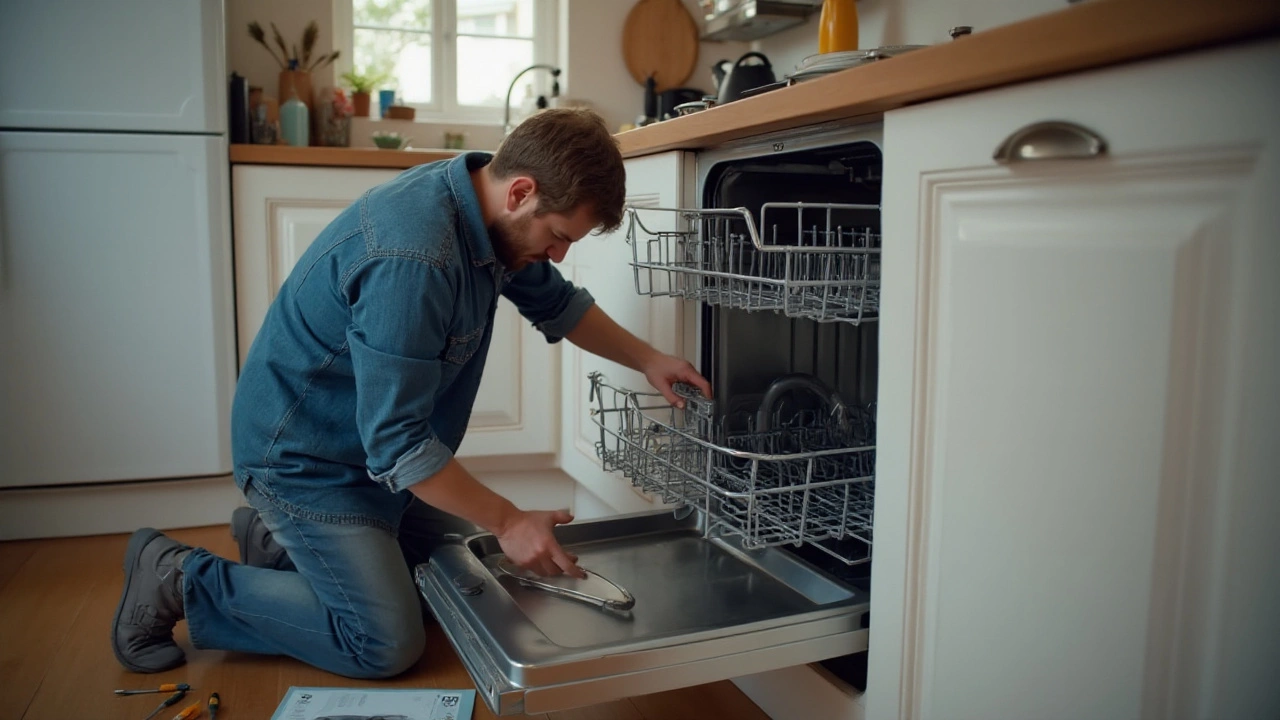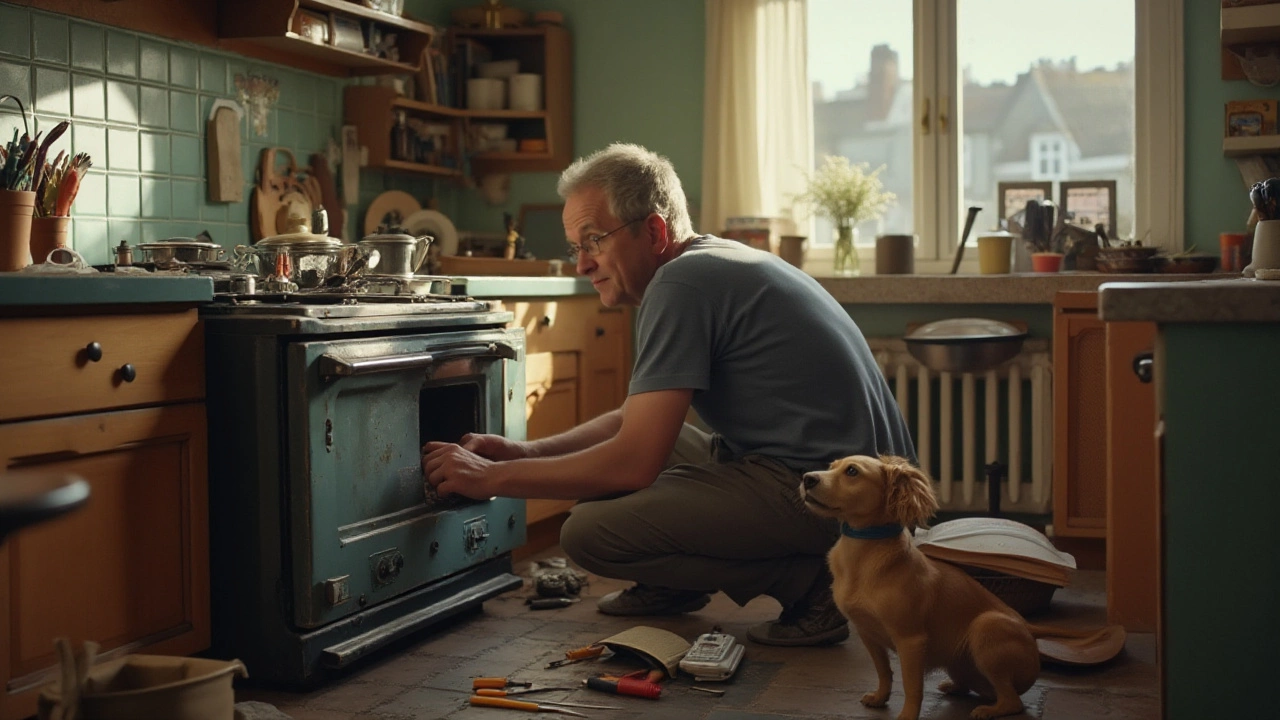
- 26 Oct 2024
- Gideon Thornton
- 0
Finding water at the bottom of your dishwasher can be a puzzling and frustrating experience. Before you rush to call a professional, it's worth exploring some common causes that might be easily fixable. In many cases, it's something as simple as a clogged filter or stray food particles causing a blockage.
This article aims to highlight the potential reasons behind this issue, along with practical solutions to tackle it. You'll find useful insights into DIY checks and fixes that could save you time and money. If you understand the underlying problem, you can often remedy it without expert help, keeping your dishwasher in peak working condition.
Let's dive into the most frequent culprits for why water might remain in your dishwasher after a cycle, and how you can address these issues with confidence.
- Causes of Standing Water
- Checking for Drainage Issues
- Inspecting the Air Gap
- Cleaning the Dishwasher Filter
- Examining the Drain Hose
- When to Call a Professional
Causes of Standing Water
One of the first things to consider when you notice standing water in your dishwasher is the drainage system. **Dishwasher repair** often starts with understanding whether there is a blockage or malfunction within the drainage path. A common culprit is food particles that escape the clutches of the filter, making their way to block the drain. Imagine a small piece of chicken or a rogue carrot bit that got away. These small items, when built up over a series of washes, can form a sort of dam, a natural disaster in miniature, disrupting the normal flow of water out of the machine. If left unchecked, such blockage can lead to more serious problems over time, affecting the performance and potentially damaging the appliance.
Another frequent cause is related to the drain hose, which connects your dishwasher to the home's plumbing. It’s not rare for this component to become kinked or clogged. Carefully inspecting this hose can reveal if water is unable to properly exit. Additionally, sometimes the hose is simply too long, creating loops where water can get trapped. Adjusting the length or configuration of this hose is a fairly easy fix, often overlooked, but can work wonders. Cleaning this hose can often ensure that your appliance functions optimally again. Some hidden designs can even cause nightmares; hoses winding through tight spaces that were never designed for easy access, creating a scene reminiscent of a plumbing horror story.
Speaking of hidden issues, the role of the air gap must be considered as well. The air gap, a small fitting usually located above the sink, prevents dirty water from re-entering the dishwasher. When this gap is blocked, it can simulate the experience of a dreadful clogged artery, preventing water from siphoning out of the dishwasher properly. In households where hard water is an issue, mineral deposits can easily collect and form blockages in these air gaps. Cleaning or replacing the air gap component can restore proper function, turning a nightmare scenario back into a well-oiled machine.
All these factors culminate in a common outcome – water that should be draining pooling at the bottom of your **dishwasher**. A statistic worth pondering is that almost 30% of dishwasher malfunctions reported annually in service calls are due to improper drainage. This points to the fact that while our dishwashing technology has advanced, some basic principles remain constant; water must have a clear path to exit. Not understanding or addressing this can result in costly repairs. James Doubleday, an appliance expert, often emphasizes,
"A stitch in time saves nine, especially when dealing with dishwashers."His advice resonates with the need for regular maintenance checks and timeliness in addressing minor issues before they escalate into major problems.
Checking for Drainage Issues
Troubleshooting dishwasher problems involves a thoughtful evaluation of its drainage capabilities. Often, water pooling in the appliance can be linked to a blockage somewhere in the drainage system. The first step in resolving this annoying problem is to understand its root, which could range from a minor obstruction to more complex mechanical faults.
Begin your inspection by examining the dishwasher's ability to expel water. It's essential to do this when the appliance is not operating, ensuring both safety and convenience. Remove any visible objects that might be preventing the proper flushing of water. In many instances, food scraps, bits of wrappers, or even glass shards may have found their way into the filter or drain, leading to a partial or complete blockage. A clean filter not only enhances the efficiency of the cleaning process but is also a straightforward way to prevent standing water. Regularly maintaining this part of the appliance ensures it functions as expected.
Another critical component to inspect is the drain pump, typically located beneath the dishwasher. Debris can sometimes cause the pump to stop working correctly. By bypassing the regular cleaning cycle, blocked particles may end up here, hindering the drainage process. Ensure you disconnect power before investigating this part to safeguard against electrical concerns. In some instances, carefully removing the pump and giving it a thorough clean or checking for damage can remedy any drainage woes.
“Routine maintenance of your dishwasher, much like any household appliance, can extend its lifespan and save you from expensive repairs,” advises Amelia Jenkins, home appliance expert at Efficient Living Magazine.
An often-overlooked cause of poor drainage might be the garbage disposal unit. If your dishwasher is connected to one, ensure it’s free of blockages, too. Often, the dishwasher's drain hose is connected here, and a blockage or even the presence of a knockout plug left from installation could be the culprit. Investigate whether the hose is correctly installed, without kinks or bends, which could impair the flow of water.
Dishwasher troubleshooting often requires creativity to get ahead of common issues, but staying vigilant with regular checks keeps problems manageable. It's a wise move to consult the user manual specific to your make and model when diagnosing or replacing components as the configuration can vary. Even minor adjustments can make a world of difference, preventing those inconvenient moments when you're left with a sea of water at the bottom of your appliance.

Inspecting the Air Gap
The air gap plays a crucial role in preventing dirty water from backflowing into your dishwasher, keeping it as clean as possible. Consider it a vital part of your kitchen's plumbing system. This little device, often mounted on the sink or countertop, creates a break in the drain line. It's designed to keep the used water separate from the fresh water supply, effectively blocking any unwanted backflow. When water pools at the bottom of the dishwasher, one of the first places to check is the air gap for clogs or blockages that might be affecting its function.
To inspect the air gap, begin by removing the cover, which is usually just a simple tug. Underneath, you'll find a cylindrical piece that can be unscrewed or gently lifted out. It might surprise you what accumulates there: bits of food, scum, and sometimes debris that you never knew your dishwasher encountered. But, fear not! These can typically be cleared away with a good cleaning, often with a stiff brush to reach into the nooks and crannies. Make sure there’s nothing left behind that could obstruct the passage of water.
Cleaning out the air gap is pretty straightforward, yet it makes a world of difference. It's good practice to clean it regularly as part of your appliance maintenance routine. If you're experiencing stubborn backflow issues, sanitation experts often suggest running a mixture of vinegar and baking soda through the system before rinsing thoroughly with hot water to ensure the pipes are spotless. It's fascinating how such a small fixture can have a massive impact on your dishwasher's efficiency.
Remember, though, if these DIY tactics don't seem to relieve the problem, and water continues to accumulate, there might be a more significant issue at play. At such times, consulting with a professional can be invaluable. As appliance expert Tom Kraeutler once said:
“Regular maintenance and timely checks are the backbone of a long-lasting appliance. When in doubt, don’t hesitate to call the pros.”Clearly, the importance of keeping these components in check cannot be understated.
Occasionally, dishwashers come with a built-in air gap or an alternative such as a drain hose with a high-loop. If this is the case, be sure to familiarize yourself with how it functions and where clogs might occur. Ensuring the hose isn’t kinked or pinched can also solve a host of drainage troubles, making this part of your regular inspection routine will undoubtedly save time in the long run.
In summary, inspecting and maintaining the air gap is often all it takes to solve standing water issues within your dishwasher. A seemingly small tube can indeed cause a big problem, but within minutes of cleaning, it can also restore your appliance to its full potential. By addressing these simple mechanical elements, you essentially safeguard the entire kitchen against pesky drainage dilemmas. It’s a small step that wards off potential bigger hurdles down the road.
Cleaning the Dishwasher Filter
One of the most common reasons for standing water in a dishwasher is a dirty or clogged filter. The filter in your dishwasher plays a crucial role in trapping food particles and preventing them from getting into the plumbing system. If not cleaned regularly, it can become clogged, leading to drainage issues. Before you start the cleaning process, ensure your dishwasher is turned off and unplugged for safety. This not only protects you but also prevents any damage to the appliance.
The location of the filter might vary based on the model, but it is usually found at the base of the dishwasher. To begin, it's advisable to remove the bottom dish rack to give you clear access to the filter. Typically, the filter is a cylindrical object that you can twist out. Be gentle but firm while removing it to avoid breaking any components, which might seem a little daunting at first, but it's quite straightforward once you try it. Regular maintenance can extend the life of your dishwasher significantly.
Once removed, inspect the filter for debris. You'll often find bits of food, grease build-up, and sometimes even small shards of broken dishes. Cleaning it is simple: rinse the filter under warm, running water. For stubborn grime, you might need a soft brush to scrub lightly and remove all particles clinging to it. Just make sure the bristles are gentle enough not to tear the mesh of the filter. An interesting fact is that experts suggest cleaning the dishwasher filter every month if you use your appliance frequently.
Reinstalling the Filter
After your filter is squeaky clean, it's time to put it back in place. Align it carefully in its slot and twist to secure it. It should fit snugly, but if you face resistance, check for obstructions that could be impeding proper placement. A well-seated filter ensures optimum washing performance and prevents recurring issues. The simple act of regular filter cleaning can save you from unnecessary dishwasher repair costs.
Proper maintenance of your dishwasher filter not only prevents water from pooling at the bottom but also helps keep your dishwasher smelling fresh and performing efficiently. An interesting tip from appliance maintenance experts is to regularly check the filter after washing particularly greasy or oily dishes. This simple proactive approach can make a significant difference in reducing the wear and tear of your appliance.
"Ignoring this small maintenance task is often the cause behind major dishwasher breakdowns," says Jane Doe, an appliance maintenance specialist.
Maintaining a clean filter is an easy way to ensure your stock of clean dishes is never depleted due to malfunction. Regularly cleaning the filter might seem like a chore, but in the long run, it keeps the dishwasher in prime condition, which makes every cleaning cycle count. Proper filter maintenance ultimately prolongs the appliance's lifespan, ensuring your trusty dishwasher serves you well for many years.

Examining the Drain Hose
When it comes to troubleshooting why there is standing water in your dishwasher, the drain hose is one of the crucial elements to inspect. Unlike some other parts of your dishwasher, the hose is relatively accessible and examining it can be a DIY-friendly task. Start by locating the drain hose, which connects the dishwasher to the household plumbing, typically under the kitchen sink. Once you find the hose, check for any kinks or bends, as these can easily prevent water from draining properly. If the hose is crimped or folded, try to straighten it out gently.
It's worth noting that clogs are a common issue with drain hoses. Food debris, soap scum, and mineral deposits can build up over time, restricting water flow. To investigate this, carefully detach the hose and use a long, flexible brush to clean out any blockages. You might be surprised by what you find inside — many homeowners discover bits of plastic, grease, or even small utensils that have somehow made their way down. Regular cleaning of the drain hose can help prevent these accumulations and keep water flowing freely.
If you're skeptical about the importance of this step, consider the words of consumer advocate and home improvement expert, Bob Vila.
"Checking and maintaining your appliances' plumbing is not just about fixing problems, it's about extending the life of the appliance," says Vila. This insight is particularly pertinent with dishwashers, where a blocked hose can lead to extensive damage if left unchecked.
Beyond physical blockages, consider if the drain hose is installed correctly. It should have a loop or high point above the entry to the drain fitting. This is often called the "high loop" method and it helps prevent wastewater from the sink or garbage disposal from siphoning back into the dishwasher. Installation guides and user manuals often overlook this step, despite its significance in preventing drainage issues.
In some cases, a visual inspection alone may not reveal a problem. In such scenarios, you might try blowing air through the hose to check if there’s resistance, indicating a blockage. Sometimes, a faint smell of stagnant water or food can also be a clue pointing to hose issues. This inspection method can be particularly useful as a quick diagnostic tool before deciding on a professional repair service.
If you find damage such as holes or cracks in the hose, replacement is often the best course of action. Usually, manufacturers offer replacement parts, and many are compatible across different dishwasher models. Purchasing a new hose is typically affordable and replacing it requires minimal effort with basic tools. Always ensure it is securely attached at both ends and that no leaks are present after installation.
When you've completed checks and necessary maintenance on the drain hose, run a test cycle without dishes to monitor whether the standing water issue persists. With this essential check, you can potentially solve one of the most common dishwasher problems efficiently and economically.
When to Call a Professional
Tackling a dishwasher issue might seem like a weekend project, but some problems are best left to the pros. So, how do you know when to make that call? It's crucial to understand certain signs that indicate the need for expert intervention. Attempting to fix complex issues without the right skills can lead to further damage, potentially costing more in the long run. Start with what you know, maybe by cleaning filters or checking the drain hose; if those simple fixes don't resolve the standing water problem, it's time to evaluate the complexity of the issue you're facing.
One key sign you need professional help is persistent standing water despite your best efforts to clear the blockage. This indicates something more significant might be amiss, like a malfunctioning pump or a more complex clog deep within the machine's drainage system. Sometimes, the issue could stem from electrical problems, and working with electricity poses a risk if you're not trained. Experienced technicians have the right tools and knowledge to safely handle and solve potentially hazardous situations.
If your machine is making unusual sounds or you notice leaks around the base, these could be signs of faulty components beyond simple clogs. Experts can conduct thorough diagnostics and identify issues that might not be evident to the untrained eye. This includes looking at the internal mechanics or electronic control boards that regulate your appliance's functionality. Dishwashers are clever machines, with intricacies that require specific expertise to fix accurately, leaving them to professionals ensures you don't void any warranties in an attempt to solve it yourself.
Another indication to call in a pro is when you've already spent time and effort trying various fixes without success. Feeling stuck can be frustrating, but consider that professionals bring years of experience and are updated with the latest appliance repair technology. They can run tests and provide options you might not have thought of. An added advantage of working with a reputable repair service is the assurance that repairs carried out are reliable and come with a service warranty.
Statistics show that common household appliances, including dishwashers, have a longer lifespan when maintained by professionals. According to an industry report, appliances serviced by trained technicians have a 20% longer operational life on average. Proper maintenance and timely repairs can indirectly contribute to energy efficiency, saving you more in the long term. Bear in mind the environmental benefits as well; professional repair rather than frequent replacements aligns with sustainable living practices.
There are times when it's not just about a quick fix but ensuring the overall longevity and efficiency of your dishwasher. As tempting as it might be to handle every home repair task yourself, knowing when to step back and call in a professional is wise. Ultimately, it provides peace of mind, ensuring that your appliance is in the hands of those who know best. If in doubt, don't hesitate to contact a qualified appliance repair service capable of diagnosing and resolving a spectrum of issues with precision and care.



